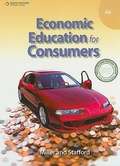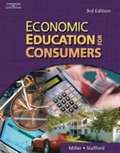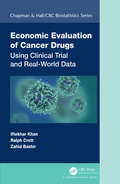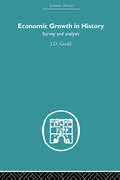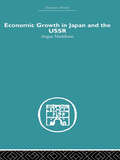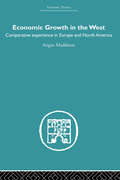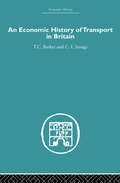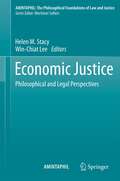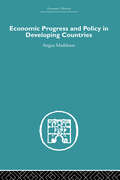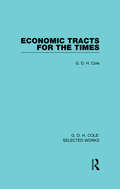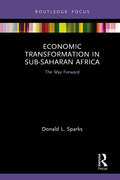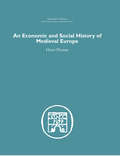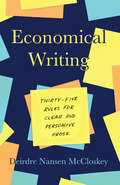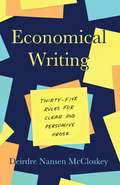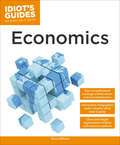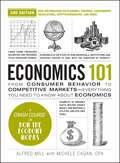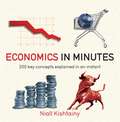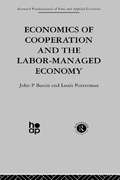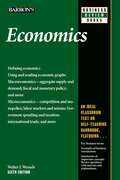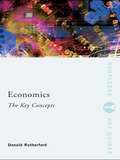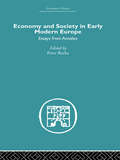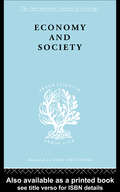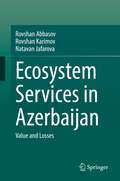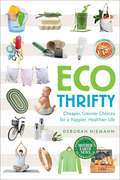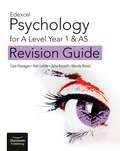- Table View
- List View
Economic Education for Consumers
by Roger Leroy Miller Alan D. StaffordECONOMIC EDUCATION FOR CONSUMERS, 4E brings economic, consumer, and personal finance topics to life. Exciting changes to this edition include a bright, new design and updated information on important changes in technology, banking, and taxes. Organized into several class-length lessons, each chapter contains several features to capture and maintain student interest, such as Consumer Alert, Vote Your Wallet, Inside the Numbers, Math of Money, What in the World?, and NetBookmark.
Economic Education for Consumers
by Roger Leroy Miller Alan D. StaffordThis textbook helps high school students to become informed consumers and prepares them to make wise financial decisions. Sample topics include choosing a career, filing taxes, budgeting expenses, using credit, and investing for the future. Among the pedagogical features is a capstone project in which students incorporate course material into a comprehensive lifespan plan for achieving their personal goals. Annotation ©2006 Book News, Inc. , Portland, OR (booknews. com)
Economic Evaluation of Cancer Drugs: Using Clinical Trial and Real-World Data (Chapman & Hall/CRC Biostatistics Series)
by Iftekhar Khan Ralph Crott Zahid BashirCancer is a major healthcare burden across the world and impacts not only the people diagnosed with various cancers but also their families, carers, and healthcare systems. With advances in the diagnosis and treatment, more people are diagnosed early and receive treatments for a disease where few treatments options were previously available. As a result, the survival of patients with cancer has steadily improved and, in most cases, patients who are not cured may receive multiple lines of treatment, often with financial consequences for the patients, insurers and healthcare systems. Although many books exist that address economic evaluation, Economic Evaluation of Cancer Drugs using Clinical Trial and Real World Data is the first unified text that specifically addresses the economic evaluation of cancer drugs. The authors discuss how to perform cost-effectiveness analyses while emphasising the strategic importance of designing cost-effectiveness into cancer trials and building robust economic evaluation models that have a higher chance of reimbursement if truly cost-effective. They cover the use of real-world data using cancer registries and discuss how such data can support or complement clinical trials with limited follow up. Lessons learned from failed reimbursement attempts, factors predictive of successful reimbursement and the different payer requirements across major countries including US, Australia, Canada, UK, Germany, France and Italy are also discussed. The book includes many detailed practical examples, case studies and thought-provoking exercises for use in classroom and seminar discussions. Iftekhar Khan is a medical statistician and health economist and a lead statistician at Oxford Unviersity’s Center for Statistics in Medicine. Professor Khan is also a Senior Research Fellow in Health Economics at University of Warwick and is a Senior Statistical Assessor within the Licensing Division of the UK Medicine and Health Regulation Agency. Ralph Crott is a former professor in Pharmacoeconomics at the University of Montreal in Quebec, Canada and former head of the EORTC Health Economics Unit and former senior health economist at the Belgian HTA organization. Zahid Bashir has over twelve years experience working in the pharmaceutical industry in medical affairs and oncology drug development where he is involved in the design and execution of oncology clinical trials and development of reimbursement dossiers for HTA submission.
Economic Growth in History: Survey and Analysis
by J.D. GouldThis book breaks fresh ground in the most challenging aspect of economics and economic history – the nature of economic growth. Professor Gould considers a wide range of theories about growth and its causes, and examines these theories in the light of modern economic history. The first chapter sketches the historical experience of growth in its broad contours. There follow discussions of the contribution made by agriculture, savings and investment, foreign trade, industrialization, technological change and a number of ‘residual’ elements. A final chapter offers a critical survey of several leading theories of economic development, judged in the light of actual historical experience. Throughout, the author has chosen to test theories rather than to deploy data of historical change and then induce theory from it. Often the result is somewhat discouraging, either because historical reality proves to be too complex to be adequately explained by even a sophisticated ‘theory’, or because practical difficulties make it impossible to subject the theory in question to a satisfactory test. Yet economists no less than economic historians will value the exercise for removing so many confusions from the study of development economics. Professor Gould’s highly readable style and avoidance of unnecessary jargon ensure that his book will be readily accessible to all those interested in problems of global poverty and economic development. This book was first published in 1972.
Economic Growth in Japan and the USSR
by Angus MaddisonIn terms of output, the USSR and Japan account for one-fifth of the world's economy, occupying second and third places behind the United States. Japan has the world's fastest growth of per capita income and the USSR has not lagged far behind. But a century ago they were static feudal societies. This study analyzes the policies which enabled them to transform their economies adn to catch up with the developed world. The strategies of the two nations adopted have been very different: Japan has maintained small farms and factories, developed a labor-intensive technology, and has successfully penetrated the world export markets. The USSR, on the other hand, has created giant farms and factories adn remained fairly isolated from world trade. Since 1945 teh USSR has devoted one-eighth of her resources to military purposes, Japan practically nothing. In Economic Growth in Japan and the USSR, Angus Maddison offers a comparative analysis of the growth experience of these two countries that greatly enlarges our knowledge of the development process. A better understanding of their past experience can be particularly illuminating and relevant for economic policy in developing countries today. This classic text was first published in 1969.
Economic Growth in the West: Comparative Experience in Europe and North America
by Angus MaddisonHailed a "an outstanding contribution to our knowledge of the way in which western economies work" [Times Literary Supplement], this penetrating study of economic growth compares and analyzes tic rates of economic advance in the twelve leading countries that comprise the industrial West. Mr. Maddison examines why, after relative stagnation for several decades, the rate of economic development accelerated in continental Europe in the 1950’s, whether this represented a new economic pattern which could be maintained or was only a passing phase of recovery after World War II. He observes that the economies of North America and the United Kingdom seemed by comparison almost to stand still, and he explores the influence of economic policy on the differing growth rates, and the growth potentials and desirable lines of policy in the industrial West. He then discusses the major powers’ policy problems, whose outcome so closely affects the developing nations. Mr. Maddison presents basic statistical series, going back to 1870 in most cases, on gross national products, productivity, population, labor force, employment, working hours, investment and capital-output ratios. He draws upon this rich fund of comparative statistics with skill and insight, relating it throughout to the broad questions of economic policy which are at issue. This classic book was first published in 1964.
Economic History of Transport in Britain
by Christopher Savage T.C. BarkerPublished in 2005, Economic History of Transport Britain is a valuable contribution to the field of Economic History.
Economic Justice: Philosophical and Legal Perspectives
by Helen M. Stacy Win Chiat LeeThe economic impact of the U. S. financial market meltdown of 2008 has been devastating both in the U. S. and worldwide. One consequence of this crisis is the widening gap between rich and poor. With little end in sight to global economic woes, it has never been more urgent to examine and re-examine the values and ideals that animate policy about the market, the workplace, and formal and informal economic institutions at the level of the nation state and internationally. Re-entering existing debates and provoking new ones about economic justice, this volume makes a timely contribution to a normative assessment of our economic values and the institutions that active those norms. Topics covered by this volumes essays range from specific or relatively small-scale problems such as payday lending and prisoners' access to adequate healthcare; to large-scale such as global poverty, the free market and international aid. Economic Justice will stimulate and provoke philosophers, policy makers, the engaged readers who and better outcomes from financial institutions and more effect distribution of economic goods.
Economic Progress and Policy in Developing Countries
by Angus MaddisonFirst published in 2005. The central issue of our times is the unequal income of nations. Its importance outweighs most of the domestic problems in rich countries, and the division of the world into rich and poor has become more significant than the ideological cleavage between communism and capitalism. There are twenty-five rich countries, but more than 100 countries who are in the where income range. Two-thirds of the world's population live in the latter group. This study focuses on those countries and looks at economic policy and progress.
Economic Tracts for the Times (Routledge Library Editions)
by G. D. ColeOriginally written as a series of pamphlets and at a time of high unemployment, this volume discusses free trade, monetary policy, wages and employment, economic theory and social legislation.
Economic Transformation in Sub-Saharan Africa: The Way Forward (Europa Introduction to...)
by Donald L. SparksSub-Saharan Africa is vastly diverse, and the 49 countries of the region range significantly in terms of population, size and economic scale. The region also differs in topography, climate, history, culture, languages and political systems. Given this vast diversity, it is, accordingly, difficult to draw general conclusions about the continent’s economic performance as a whole. Additionally, the lack of current statistics for several countries makes it difficult to make accurate assessments of economic conditions. Nevertheless, some broad comparisons can be made: of the world’s developing areas, sub-Saharan Africa has the worst record in virtually all of the most important social and economic indicators: the region has the lowest gross national income per head, the lowest life expectancy at birth, the lowest youth literacy rate, the highest rate of adult HIV infection and the highest number of children not living past five years of age. This volume begins by examining recent economic developments and trends. It then looks at the major economic constraints the region has faced in recent years, breaking down those constraints as either ‘external’ (e.g. terms of trade) over which the individual countries have but limited control, or ‘internal’ (e.g. governance and economic policy), over which there is more control. The book concludes by arguing that, despite the notable challenges cited above, sub-Saharan Africa is poised for a transformation, based on closer regional economic co-operation, a growing middle class, increased demand for locally produced goods and services, and a young population.
Economic and Social History of Medieval Europe
by Henri PirenneFirst published in 2005. Routledge is an imprint of Taylor & Francis, an informa company.
Economical Writing, Third Edition: Thirty-Five Rules for Clear and Persuasive Prose (Chicago Guides to Writing, Editing, and Publishing)
by Stephen T. Ziliak Deirdre N. McCloskeyEconomics is not a field that is known for good writing. Charts, yes. Sparkling prose, no. Except, that is, when it comes to Deirdre Nansen McCloskey. Her conversational and witty yet always clear style is a hallmark of her classic works of economic history, enlivening the dismal science and engaging readers well beyond the discipline. And now she’s here to share the secrets of how it’s done. Economical Writing is itself economical: a collection of thirty-five pithy rules for making your writing clear, concise, and effective. Proceeding from big-picture ideas to concrete strategies for improvement at the level of the paragraph, sentence, or word, McCloskey shows us that good writing, after all, is not just a matter of taste—it’s a product of adept intuition and a rigorous revision process. Debunking stale rules, warning us that “footnotes are nests for pedants,” and offering an arsenal of readily applicable tools and methods, she shows writers of all levels of experience how to rethink the way they approach their work, and gives them the knowledge to turn mediocre prose into magic. At once efficient and digestible, hilarious and provocative, Economical Writing lives up to its promise. With McCloskey as our guide, it’s impossible not to see how any piece of writing—on economics or any other subject—can be a pleasure to read.
Economical Writing, Third Edition: Thirty-Five Rules for Clear and Persuasive Prose (Chicago Guides to Writing, Editing, and Publishing)
by Deirdre Nansen McCloskeyEconomics is not a field that is known for good writing. Charts, yes. Sparkling prose, no. Except, that is, when it comes to Deirdre Nansen McCloskey. Her conversational and witty yet always clear style is a hallmark of her classic works of economic history, enlivening the dismal science and engaging readers well beyond the discipline. And now she’s here to share the secrets of how it’s done. Economical Writing is itself economical: a collection of thirty-five pithy rules for making your writing clear, concise, and effective. Proceeding from big-picture ideas to concrete strategies for improvement at the level of the paragraph, sentence, or word, McCloskey shows us that good writing, after all, is not just a matter of taste—it’s a product of adept intuition and a rigorous revision process. Debunking stale rules, warning us that “footnotes are nests for pedants,” and offering an arsenal of readily applicable tools and methods, she shows writers of all levels of experience how to rethink the way they approach their work, and gives them the knowledge to turn mediocre prose into magic. At once efficient and digestible, hilarious and provocative, Economical Writing lives up to its promise. With McCloskey as our guide, it’s impossible not to see how any piece of writing—on economics or any other subject—can be a pleasure to read.
Economics (Idiot's Guides)
by Terry HillmanWritten at a high school level, Idiot's Guides: Economics offers beginners an easy-to-understand exploration of this always-complex topic. Covering microeconomics and macroeconomics, this fascinating guide incorporates helpful infographics and illustrations to make learning easier. This economics book explores dozens of topics including market efficiency; government regulation and intervention; unemployment and inflation; fiscal and monetary policy; social safety net; and much more.
Economics 101, 2nd Edition: From Consumer Behavior to Competitive Markets—Everything You Need to Know about Economics (Adams 101 Series)
by Michele Cagan Alfred MillDiscover the ins and outs of the economy with this engaging, informative, and easy-to-navigate 2nd edition guide with all-new entries and updates.Too often, textbooks turn the noteworthy details of economics into tedious discourse that would put even Joseph Stiglitz to sleep. This new edition of Economics 101 cuts out the boring explanations and instead provides a hands-on lesson that keeps you engaged as you explore how societies allocate their resources for maximum benefit. From quantitative easing to marginal utility, this primer is packed with hundreds of entertaining tidbits and concepts that you won&’t be able to get anywhere else. You&’ll learn the basics on terms such as monopolies and oligopolies, game theory, inflation, price ceilings, and so much more. Have you ever wondered about the origin of banking or how banks create money? This book has all the answers. Whether you&’re looking to master major principles of finance or just want to learn more about why money matters, Economics 101 has all the answers—even the ones you didn&’t know you were looking for.
Economics in Minutes
by Niall KishtainyEconomics in Minutes condenses key economics concepts into 200 short and easily digested essays. Featuring not only fundamental ideas, such as the role of money and how the stock market works, but also subjects that are increasingly important to us today - unemployment, government debt and corporate tax avoidance, for example. Economics in Minutes is the ideal introduction to a complex and vital subject.Key topics are succinctly described and accompanied by illustrations, making them simple to read and easy to remember. This convenient little reference guide will allow readers to understand the theories underpinning a subject that affects our lives on a daily basis.Chapters include: Supply and demand, globalization, market failure, GDP and happiness, risk and uncertainty, living standards and productivity, Game theory, economics and culture.
Economics of Cooperation and the Labour-Managed Economy
by J. Bonin L. PuttermanDiscusses the theory of labour-managed firms or producers' cooperatives, and of economies companies principally of such firms.
Economics, 6th edition (Barron's Business Review Series)
by Walter J. WesselsA thoughtful and comprehensive guide to Economics with crystal-clear summaries and explanationsBooks in this series are designed for classroom use, summarizing key concepts and presenting review questions with answers and explanations. This new edition:Defines economicsDemonstrates the uses of graphsDiscusses the law of supply and demand Covers macroeconomics topics including national output, inflation, unemployment, aggregate demand and supply, the Keynesian model, monetary policy, and moreCovers microeconomics topics including monopolies, forces that promote competition, game theory, labor markets and unions, government spending and taxation, and more.
Economics: The Key Concepts (Routledge Key Guides)
by Donald RutherfordAn A-Z of contemporary economics in all its forms, Economics: the Key Concepts is an affordable, accessible reference for students, lecturers and economists at every level. The key topics explored include: competition and monopoly development economics game theory property rights taxation. Fully cross-referenced with extensive guides to further reading, this is the essential comprehensive pocket reference to the ideas, issues and practice of economics in the twenty-first century.
Economy and Society in Early Modern Europe: Essays from Annales
by Peter BurkeIn 1929 two French historians, Lucien Febvre and Marc Bloch, founded Annales, a historical journal which rapidly became one of the most influential in the world. They believed that economic history, social history and the history of ideas were as important as political history, and that historians should not be narrow specialists but should learn from their colleagues in the social sciences. Two of the most distinguished French members of the Annales school are represented in this volume - Fernand Braudel and Emmanuel Le Roy Ladurie - the core of which is the debate on the Price Revolution of the sixteenth century dealt with by Cipolla, Chabert, Hoszowski and Verlinden. Within the volume, all the contributions are oriented towards Europe in the sixteenth and seventeenth centuries, and all are concerned with long-term changes, and with the relation between economic growth and social change. It includes articles on the European movement of expansion discussed by Malowist and the activities of the Hungarian nobles as entrepreneurs discussed by Pach, and two articles on wider issues: Le Roy Ladurie on the history of climate, and Braudel, summing up the Annales programme, on the relation between history and the social sciences. This classic text was first published in 1972.
Economy and Society: A Study in the Integration of Economic and Social Theory (International Library of Sociology)
by Neil Smelser Talcot ParsonsThis volume is designed as a contribution to the synthesis of theory ineconomics and sociology. We believe that the degree of separationbetween these two disciplines separation emphasized by intellectualtraditions and present institutional arrangements arbitrarily concealsa degree of intrinsic intimacy between them which must be brought tothe attention of the respective professional groups.
Ecosystem Services in Azerbaijan: Value and Losses
by Rovshan Abbasov Rovshan Karimov Natavan JafarovaThis book aims to draw readers' attention to the benefits once present nature in Azerbaijan. Over the past hundred years, much of this has been lost because of the neglect of the intrinsic values of nature by both managers and local authorities, and the overuse of natural resources. For example, oil pollution and overfishing in the Caspian Sea have almost destroyed its fish and caviar resources. In this volume, the authors distinguish between the concepts of "gain" and "income" and show readers that short-term benefits based solely on monetary income deprive people and nature itself of long-term, lasting value. The book provides readers with real historical information, discusses the interactions between humans and nature, and shows, with real data and trends, the consequences of anthropogenic activity on natural resources in Azerbaijan. The authors cover fish, water, forest, mountain, and pasture ecosystems, draw attention to the impacts that pollution and other forms of environmental degradation have had on these resources, and the show the impact that resource depletion on people’s livelihoods. The book is intended primarily for managers, policymakers, students, and academics, and will be of interest to natural scientists, historians, and students of culture.
Ecothrifty: Cheaper, Greener Choices for a Happier, Healthier Life (Mother Earth News Books for Wiser Living)
by Deborah NiemannA guide to saving a fortune while saving the Earth, from the author of Homegrown & Handmade. Use it up, wear it out, make it do, or do without. Our grandmothers knew the importance of responsible, thrifty choices. But somewhere along the way we lost our way and succumbed to the belief that we can get everything for next to nothing, have it shipped halfway around the world and then—more often than not—just throw it away. This consumer binge is taking its toll. Diet and lifestyle-related illnesses are epidemic, our environment is awash in a sea of plastic, our climate is changing, and the cost of everything is skyrocketing with the price of oil. Are we doomed? No. We can make greener, healthier choices, and we can do it while saving money. Where to start? Ecothrifty is packed with simple, practical ideas and recipes to help you:· Make homemade products for cleaning and skin care · Grow your own food and cook more from scratch · Raise your family without lowering your standards A must-read for anyone who has ever wanted to live a greener life but thought that it would be too expensive, time-consuming, or difficult, this handy, complete guide will show you how small changes can have a huge environmental impact and save you thousands of dollars, all while improving your quality of life.&“I support and endorse this wonderful book, 100%!&” —Ed Begley, Jr., actor and environmentalist&“Her advice does not come across as self-righteous or preachy, but more like insider tips from an experienced do-it-yourselfer.&” —Publishers Weekly
Edexcel Psychology for A Level Year 1 & AS: Revision Guide
by Cara Flanagan Julia Russell Rob Liddle Mandy WoodThe portable-sized Revision Guide is ideal for consolidating knowledge both at home for revision, and at school as a lesson-by-lesson summary as the course progresses. / Each topic is covered on one spread helping students get straight to the point. / Description (AO1) is on the left of the spread split into separate segments to aid revision. / Evaluation (AO3) is on the right, each point illustrating the all-important chains of reasoning. / Exam-style questions, including AO2 application questions on concepts and methods, are on every spread providing lots of practice. / Detailed exam advice section is included, with hints and tips offered throughout the book. / Lots of illustrations and the odd corny joke help make it very user-friendly!
